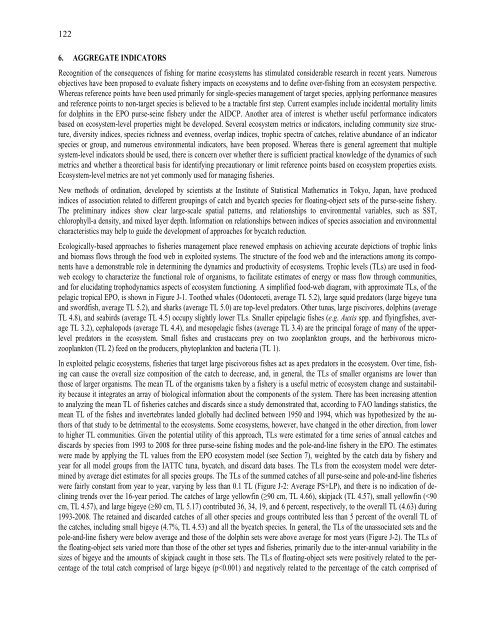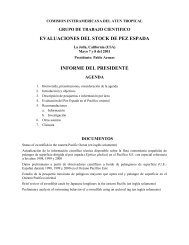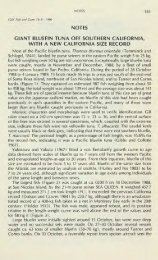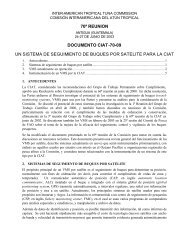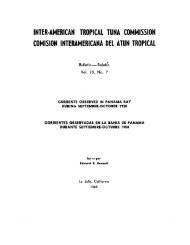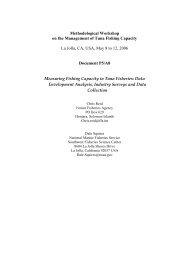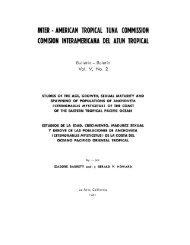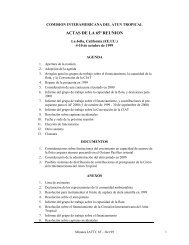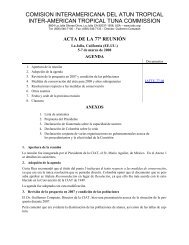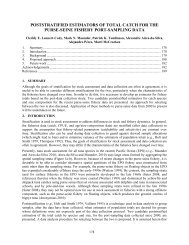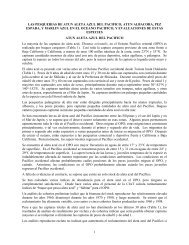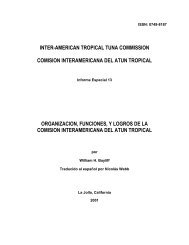INTER-AMERICAN TROPICAL TUNA COMMISSION - Comisión ...
INTER-AMERICAN TROPICAL TUNA COMMISSION - Comisión ...
INTER-AMERICAN TROPICAL TUNA COMMISSION - Comisión ...
- No tags were found...
Create successful ePaper yourself
Turn your PDF publications into a flip-book with our unique Google optimized e-Paper software.
1226. AGGREGATE INDICATORSRecognition of the consequences of fishing for marine ecosystems has stimulated considerable research in recent years. Numerousobjectives have been proposed to evaluate fishery impacts on ecosystems and to define over-fishing from an ecosystem perspective.Whereas reference points have been used primarily for single-species management of target species, applying performance measuresand reference points to non-target species is believed to be a tractable first step. Current examples include incidental mortality limitsfor dolphins in the EPO purse-seine fishery under the AIDCP. Another area of interest is whether useful performance indicatorsbased on ecosystem-level properties might be developed. Several ecosystem metrics or indicators, including community size structure,diversity indices, species richness and evenness, overlap indices, trophic spectra of catches, relative abundance of an indicatorspecies or group, and numerous environmental indicators, have been proposed. Whereas there is general agreement that multiplesystem-level indicators should be used, there is concern over whether there is sufficient practical knowledge of the dynamics of suchmetrics and whether a theoretical basis for identifying precautionary or limit reference points based on ecosystem properties exists.Ecosystem-level metrics are not yet commonly used for managing fisheries.New methods of ordination, developed by scientists at the Institute of Statistical Mathematics in Tokyo, Japan, have producedindices of association related to different groupings of catch and bycatch species for floating-object sets of the purse-seine fishery.The preliminary indices show clear large-scale spatial patterns, and relationships to environmental variables, such as SST,chlorophyll-a density, and mixed layer depth. Information on relationships between indices of species association and environmentalcharacteristics may help to guide the development of approaches for bycatch reduction.Ecologically-based approaches to fisheries management place renewed emphasis on achieving accurate depictions of trophic linksand biomass flows through the food web in exploited systems. The structure of the food web and the interactions among its componentshave a demonstrable role in determining the dynamics and productivity of ecosystems. Trophic levels (TLs) are used in foodwebecology to characterize the functional role of organisms, to facilitate estimates of energy or mass flow through communities,and for elucidating trophodynamics aspects of ecosystem functioning. A simplified food-web diagram, with approximate TLs, of thepelagic tropical EPO, is shown in Figure J-1. Toothed whales (Odontoceti, average TL 5.2), large squid predators (large bigeye tunaand swordfish, average TL 5.2), and sharks (average TL 5.0) are top-level predators. Other tunas, large piscivores, dolphins (averageTL 4.8), and seabirds (average TL 4.5) occupy slightly lower TLs. Smaller epipelagic fishes (e.g. Auxis spp. and flyingfishes, averageTL 3.2), cephalopods (average TL 4.4), and mesopelagic fishes (average TL 3.4) are the principal forage of many of the upperlevelpredators in the ecosystem. Small fishes and crustaceans prey on two zooplankton groups, and the herbivorous microzooplankton(TL 2) feed on the producers, phytoplankton and bacteria (TL 1).In exploited pelagic ecosystems, fisheries that target large piscivorous fishes act as apex predators in the ecosystem. Over time, fishingcan cause the overall size composition of the catch to decrease, and, in general, the TLs of smaller organisms are lower thanthose of larger organisms. The mean TL of the organisms taken by a fishery is a useful metric of ecosystem change and sustainabilitybecause it integrates an array of biological information about the components of the system. There has been increasing attentionto analyzing the mean TL of fisheries catches and discards since a study demonstrated that, according to FAO landings statistics, themean TL of the fishes and invertebrates landed globally had declined between 1950 and 1994, which was hypothesized by the authorsof that study to be detrimental to the ecosystems. Some ecosystems, however, have changed in the other direction, from lowerto higher TL communities. Given the potential utility of this approach, TLs were estimated for a time series of annual catches anddiscards by species from 1993 to 2008 for three purse-seine fishing modes and the pole-and-line fishery in the EPO. The estimateswere made by applying the TL values from the EPO ecosystem model (see Section 7), weighted by the catch data by fishery andyear for all model groups from the IATTC tuna, bycatch, and discard data bases. The TLs from the ecosystem model were determinedby average diet estimates for all species groups. The TLs of the summed catches of all purse-seine and pole-and-line fisherieswere fairly constant from year to year, varying by less than 0.1 TL (Figure J-2: Average PS+LP), and there is no indication of decliningtrends over the 16-year period. The catches of large yellowfin (≥90 cm, TL 4.66), skipjack (TL 4.57), small yellowfin (


